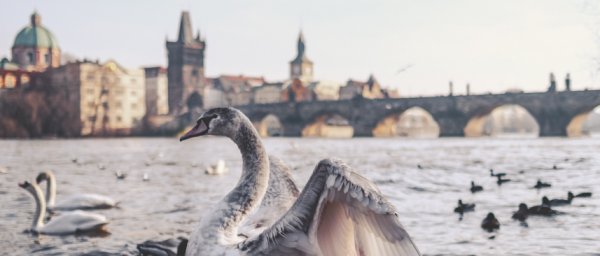06 October 2021 Places
A Guide to Prague – Must-see Tourist Attractions in the Golden City
The capital of the Czech Republic is one of the centres of eastern European history. It is flooded with tourists at any time of the year and is one of those places that are easy to fall in love with at first sight. For that love to last, Prague gradually reveals a multifaceted cultural, artistic, historical landscape. This unique city stretches along the banks of one of the largest rivers in Europe. In addition to being home to the world’s oldest castle, impressive parks and orchards are strewn through the heart of the city. Prague is a place where tourists can indulge their palettes by enjoying authentic local cuisine and the tastes of real Czech beer.

The flight from Belgrade to Prague takes only an hour and forty minutes. Departures are scheduled twice a week, from Belgrade and other cities. Passengers can purchase their tickets through the Air Serbia website. By subscribing to the Newsletter you can stay informed about discounted ticket prices and new departures.
Prague - a fairytale town on the banks of the Vltava
Prague's architecture is the first thing that enchants visitors who step foot in the Czech capital. This city is small in comparison to some of Europe’s other megalopolises, home to around a million inhabitants. What it lacks in size it makes up for with its unique charm as a kind of open-air museum. The old city centre is under the protection of UNESCO as a place of great historical and cultural significance. The declaration Prague town centre as a cultural monument has resulted in a ban on non-electric vehicles in this part of the city, with the aim of protecting the building facades. A tour of Prague should start right from its centre with a walk over the Charles Bridge. This bridge is located on the site of Judith's bridge, which was destroyed in the flood of 1342. Charles Bridge was built in 1402, and until the middle of the 19th century it was the only bridge that connected Prague’s two shores. It is characterized by the towers and statues adorn it, the most famous of which is the one that represents St. Joh of Nepomuk. The evening is the best time to walk along this bridge, which is also a gathering place for a large number of street artists and souvenir vendors.

The next unavoidable attraction is Hradčany, a complex that surrounds the Prague Castle. The castle itself dates from the 9th century, and is believed to be the largest and oldest wooden castle in the world. Today, it houses the official residence of the President of the Czech Republic. Part of the castle is open to tourists. In the square in front of the castle, tourists can attend the change of guard that happens every hour – its certainly a sight to behold. The complex is also the site of the Cathedral of St. Vita, built in the Gothic style characteristic of Prague architecture. The interior of the cathedral’s interior is breathtaking, and its two towers dominate Prague’s panorama.
While you’re there you can visit the Višehrad, complex. According to legend, this was the place from which Prague began to develop into the city it is today. The site is large – visiting it and can fill an entire day. It houses the church of St. Peter and Paul and the cemetery of honorary citizens of Prague, where Smetana and Dvorak are buried.
The capital of the Czech Republic as an open-air museum
A walk through the centre of Prague is reminiscent of a visit to a large open-air museum. For a start, there is “Zlatna ulica” (gold street), near the Prague Castle, named after the fact that goldsmiths' conglomerated in and around it throughout the 16th century and beyond.
Legend has it that alchemists who tried to turn iron into gold also lived in this street during the reign of Emperor Rudolf II. Today it is a small, winding street full of houses with colourful facades, the vast majority of which have been turned into small open-air museums, which house objects from households and goldsmith workshops of the 16th century. The house at number 22 is especially interesting, because Franz Kafka lived in it in the period from 1916 to the end of 1917.
At the Old Town Square, you can visit the famous Prague Astronomical Clock. First installed in the 14th century, it is the world’s oldest clock still in operation. On the hour, the windows of the clock open and the figures of Jesus and the 12 apostles are set in motion. Astronomical signs for the sun, moon and other planets can also be seen on the clock, as well as various zodiac symbols. Next to the Astronomical Clock is the Týnský chrám, or The Church of Our Lady Before Tyn, where you can see the oldest organ in Prague, dating from the late 17th century. Two impressive towers named Adam and Eve straddle the church’s nave.

The cultural and business centre of Prague is centred around Wenceslas Square, just above the old town. It is named after Prince Wenceslaus I, whose statue is located in the very centre of the boulevard. The boulevard ends in front of the National Museum and includes exhibits of the state crown and royal insignia, works by Czech painters, and historical objects from the 9th century. Must-see museums in Prague include the Kafka Museum and the Jewish Quarter, where you can visit the oldest active synagogue in Europe or and the Jewish cemetery.
Culinary Prague - discovering traditional flavours in a new way
For the lovers of the finer things in life making their way through Europe, Prague is an unavoidable stop. Tourists visiting the city choose some of the countless pubs to get acquainted with traditional Czech cuisine and brewing culture. In them you can try goulash, traditionally cooked pork knees, iconic Czech dumplings, or an inverted sandwich. In addition to cooked dishes in restaurants and pubs, stalls and hot dog stands selling sausages can be found at almost every step and can spice up your experience of walking the city streets. The most popular sweets are trdelnik, a kind spit cake that can be eaten empty or filled with ice cream, cream, or jam, as well as traditional honey cakes typically eaten together with an afternoon coffee in the old town centre. In addition to its rich culinary heritage, Prague is well known for having some of the finest beer in the world on offer. In addition to popular beers such as Pilsner Urkel, Krušovice and Staropramen, almost every pub on offer has its own home-brewed beer, which come with interesting combinations of flavours. The Czechs are passionate beer drinkers. It isn’t unusual to see groups of young people walking down the street and drinking their favourite beer. The night life of the city starts in the afternoon and concentrates especially around the centre. However, due to the ban on noise after 10 pm, all nightclubs and bars are located underground. Most of them have kept their original interiors, so you can often see combinations of stone walls and old wood, which imbue nights out on the town with a little alternative spirit.

Subscribe and don't miss out on our special offers.







